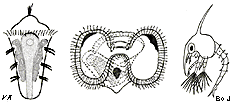Small organism´s food web
Small particles and soluble organic material
are filtered out of the sea water when they pass through the bottom sediment.
Microalgae exploit this source of food and produce new organic material.
Both the newly produced and the imported material support the food web
that is made up of bottom-living micro-organisms.
Bacteria and fungi further break down organic material and
themselves eat single celled creatures (protozoas). Bakteria, fungi and
protozoas are then eaten by small creatures, many of which are less than
one millimetre in size. These specie are then in turn eaten by other small
specie.
On most sand beaches, the links in the food chain between
the smaller and larger animals are quite vague, because many of the larger
animals have the ability to filter their food out of the water. The flow
between the different food webs is believed to be larger in more protected
beach environments.
Variations in quantity and specie
It is common to find different organisms
on different beaches that are close to each other and where composition
and populations vary from year to year and with the seasons.
Many of the larger animals that live on the beach as adults
have eggs and larvae
that drift
in the sea. One explanation of these differences can be that the larvae
of different specie arrive on the sand bottoms in varying numbers.

Magnified larvae of a polychaete, periwinkle and a crab.
|

|
Page 11
of 15
|

|
|